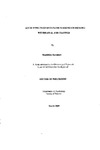ACUTE EFFECTS OF SELF-PACED WALKING ON SMOKING WITHDRAWAL AND CRAVINGS
| dc.contributor.author | Katomeri, Magdalena | |
| dc.contributor.other | School of Psychology | en_US |
| dc.date.accessioned | 2013-11-01T12:35:58Z | |
| dc.date.available | 2013-11-01T12:35:58Z | |
| dc.date.issued | 2009 | |
| dc.identifier | NOT AVAILABLE | en_US |
| dc.identifier.uri | http://hdl.handle.net/10026.1/2537 | |
| dc.description | Merged with duplicate record 10026.1/644 on 27.02.2017 by CS (TIS) | |
| dc.description.abstract |
High relapse rates among smokers attempting to quit have been linked with failure to cope with cigarette cravings and withdrawal symptoms. Smoking cravings and withdrawal behavior is known to be influenced by stress and exposure to smoking cues. Exercise appears to reduce cigarette cravings and withdrawal symptoms. However no study has investigated the effects of exercise on cue-elicited cravings and withdrawal symptoms, or on ad libitum smoking behavior. Aim: Four experimental studies were designed to examine the effects of exercise on smoking behavior. Initial studies focused on the effects of a single session of brisk walk on cigarette cravings and withdrawal symptom. Further research examined the effects of the walk on withdrawal symptoms and cravings and response to smoking cues and time spent on ad libitum smoking. Methods: All studies examined the effects of a short bout of brisk walking (15- 20 minutes) versus a passive control condition. For the purposes of the experiments, participants were temporarily smoking abstinent or non-abstinent. Multiple and single item measures of cravings and withdrawal, as well as different experimental designs were used in order to enhance the reliability of the findings. In Studies 2, 3, and 4 after the exercise (or the control) participants were exposed to smoking cues. In these studies after the laboratory session, ad libitum smoking was determined from the subject's cell phone text message. Results: Cigarette cravings, withdrawal symptoms and negative affect decreased rapidly during exercise and remained reduced for 20-50 minutes after exercise. This pattern was robust across the four studies, across different abstinent periods, across single and multiple measures of cravings and withdrawal symptoms, across experimental designs and across samples. Furthermore, it was shown that exercise attenuated increases in cue elicited cravings and withdrawal symptoms. Results also indicated a two- to threefold longer time to the next cigarette following exercise. Exercise produced these effects by mimicking the relaxing effects of smoking. Conclusions: Short bouts of brisk walk are recommended as an aid to managing cigarette cravings and withdrawal symptoms. | en_US |
| dc.language.iso | en | en_US |
| dc.publisher | University of Plymouth | en_US |
| dc.title | ACUTE EFFECTS OF SELF-PACED WALKING ON SMOKING WITHDRAWAL AND CRAVINGS | en_US |
| dc.type | Thesis | |
| plymouth.version | Full version: final and full version as approved by the examiners at the time of the award of your degree | en_US |
| dc.identifier.doi | http://dx.doi.org/10.24382/4451 | |
| dc.identifier.doi | http://dx.doi.org/10.24382/4451 |
Files in this item
This item appears in the following Collection(s)
-
01 Research Theses Main Collection
Research Theses Main


